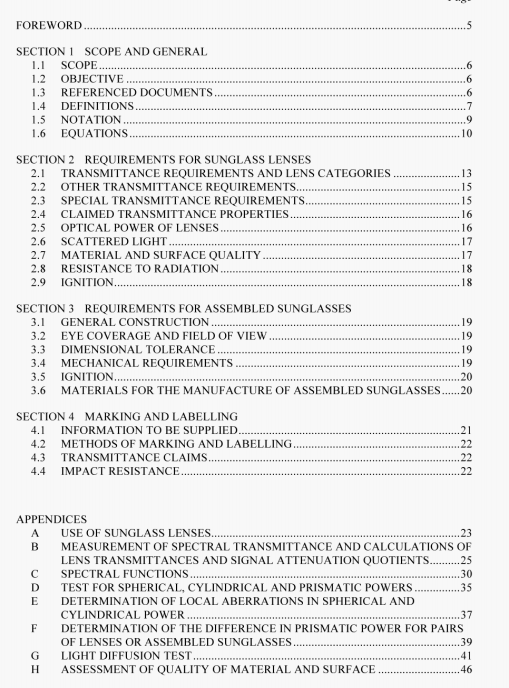AS/NZS 1067:2003 pdf – Sunglasses and fashion spectacles.
2.1 TRANSMITTANCE REQUIREMENTS AM) LENS CATEGORIES
2.1.1 Lens categories
Sunglass lenses shall be classified into five lens categories. where category 0 applies only
(a) Photochromic lenses in the faded state.
(b) Gradient lenses with a luminous transmittance greater thaii 80% at the reference point.
(c) Lenses that have a luminous transmittance greater than 80%. hut where a specific protection against any part of the solar spectrum is claimed.
The range of the luminous transmittance of these five categories is gien by the values in
Table I. The overlap of the luminous transmittance values shall he not more than ±2%
(absolute) between the categories 0. 1. 2 and 3.
2.1.2 Transmittance requirements
Sunglass lenses in a given lens category shall meet the requirements set out in Table I when measured at the reference points of the lenses.
The requirements of Table 1 apply to all kinds of sunglass lenses including uniformly tinted, gradient density, polarizing and photochromic lenses.
Photochromic lenses shall meet the requirements in both the faded and darkened states. A sunglass lens shall meet the requirements for ultraviolet radiation in Table I at all points within a circle 28 mm in diameter centred on the reference point.
2.1.3 Claims of luminous transmittance
If the supplier claims a luminous transmittance value for a sunglass lens, for categories 0 to 3. it shall be within ±3% absolute of the measured values and for Category 4 it shall be within ±30% relative to the measured value.
When stating the transmittance properties of photochromic lenses, at least two categories for transmittance values, t and t1 shall he used. These two values correspond to the faded state and to the darkened state of the lens respectively.
In order to provide a minimum field of view and area of UV protection, the following provisions shall apply to assembled sunglasses with Category 2 3 and 4 lenses including one-piece visors, clip-ons and slip-ons.
3.2.1.2 Assembled sunglasses
The lenses of assembled sunglasses that are not labelled as children’s sunglasses shall cover two ellipses of horizontal diameter of 40 mm and a vertical diameter of 28 mm, the centres of which are separated by 64 mm and symmetrically placed on either side of the centre of the nose bridge of the frame.
3.2.1.3 Children’s sunglasses
The lenses of assembled sunglasses which are labelled as children’s sunglasses shall cover two ellipses of horizontal diameter of 34 mm and a vertical diameter of 24 mm, the centres of which are separated by 54 mm and symmetrically placed on either side of the centre of the nose bridge of the frame.
3.2.1.4 Clip—otis and slip—otis
Clips-ons and slip-ons shall meet the requirements of Clauses 3.2.1.2 and 3.2.1.3 unless they are designed for and sold as an accessory to be used with a particular spectacle frame fitted with prescription lenses.
AS/NZS 1067:2003 pdf – Sunglasses and fashion spectacles
